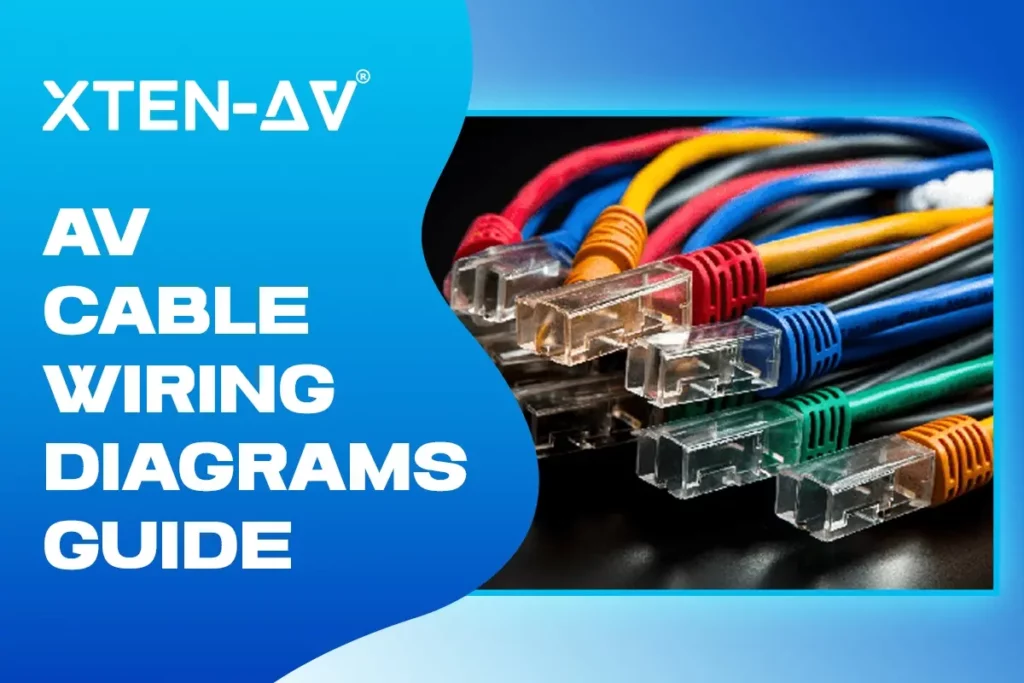AV Cable Wiring Diagrams: Visualize Your Audio Visual Connections Easily
Welcome to our comprehensive guide on AV cable wiring diagrams and the modern tools shaping the landscape of AV design. In today’s fast-paced world, the demand for seamless audiovisual experiences has never been higher, making the creation of accurate and efficient wiring diagrams a crucial aspect of AV integration. In this guide, we’ll explore the importance of AV cable wiring diagrams, delve into the methods employed by modern AV designers, and introduce a cutting-edge software solution, X-DRAW, designed to revolutionize the process. Whether you’re a seasoned AV professional or a newcomer to the industry, this guide will provide valuable insights into optimizing your AV setup for peak performance.
Key Takeaways
- Explore the intricacies of AV cable wiring diagrams and their essential role in audiovisual setups.
- Understand AV connection diagrams to optimize your audiovisual wiring configurations.
- Trace the evolution of audiovisual cabling diagrams, from manual sketches to modern software solutions like X-DRAW.
- Discover innovative methods used by modern AV designers, including 3D modeling and automated cable routing.
- Improve your AV design proficiency with X-DRAW, a software tailored for creating precise and efficient AV wiring diagrams.
What is an AV Cable Wiring Diagram?
An AV cable wiring diagram is a visual representation of how audio and video cables should be connected to transmit signals between devices effectively. It typically illustrates the layout and connections of various components, such as TVs, DVD players, gaming consoles, and speakers, using different types of cables like RCA, HDMI, or component cables.
Key pointers in an AV connection diagram include:
An AV connection diagram serves as a practical guide for setting up home entertainment systems or professional AV setups, ensuring correct connections for seamless audio and video transmission.
- Device Identification: Each device, such as a TV, DVD player, or stereo receiver, is labeled to identify its role in the setup.
- Cable Types: Different types of cables are depicted, such as RCA (red, white, yellow), HDMI (high-definition multimedia interface), or component cables (red, green, blue).
- Connection Paths: Arrows or lines indicate the direction of signal flow, showing how audio and video signals travel from one device to another.
- Input/Output Ports: The diagram highlights each device’s input and output ports and specifies where AV cables should be plugged in for optimal performance.
- Signal Splitting/Merging: If applicable, the diagram may show how signals are split or merged using splitters or switchers to accommodate multiple devices or displays.
- Audio Channels: For surround sound systems, the diagram may illustrate how audio channels are routed to speakers for immersive sound experiences.
Why is an AV Cable Wiring Diagram Important?
An AV cable wiring diagram promotes efficiency, accuracy, and optimal performance in setting up and maintaining audiovisual systems, making it an essential tool for both novice and experienced users. An AV cable wiring diagram holds significant importance for several reasons:
- Clarity and Accuracy: It provides a clear and accurate depiction of how audio and video components should be connected. This reduces the risk of incorrect setups, preventing potential damage to devices or subpar performance.
- Efficiency: Following a wiring diagram streamlines the setup process, saving time and effort. Users can quickly identify which cables go where, minimizing guesswork and frustration.
- Optimal Performance: Proper cable connections, as outlined in the diagram, ensure optimal performance of audio and video equipment. This leads to better sound and picture quality, enhancing the overall viewing or listening experience.
- Troubleshooting: A wiring diagram serves as a reference point for technical issues or troubleshooting needs. Users can easily trace connections to identify potential sources of problems and resolve them efficiently.
- Flexibility and Expansion: With a clear understanding of the existing setup, users can easily expand or modify their AV systems in the future. They can add new components or rearrange existing ones while maintaining organized and effective cable connections.
How Were AV Integrators Creating Audio Visual Cable Wiring Diagrams Before?
It was common for AV integrators to create Audio Visual cable wiring diagram using traditional methods before the advent of digital tools and software. Since audiovisual technology has been around for quite some time, many of these early diagrams were drawn by hand on paper or using rudimentary drafting software. AV integrators would spend hours sketching out the arrangement of the devices and the connections between them, utilizing symbols or labels to identify the cables and ports. These diagrams involved a lot of measuring and precise drawing to ensure that the wires were set up correctly.
As technology progressed, some AV integrators switched to creating wiring diagrams using computer-aided design software (CAD). CAD software was more flexible than hand-drawn wiring diagrams and could be easily edited to change or correct information. AV integrators found it easier to create more professional visual representations using standardized symbols and layouts on CAD software.
In recent years, the advent of specialized AV design software has further revolutionized the process of creating wiring diagrams for AV systems. These software solutions are specifically tailored to the needs of AV integrators, offering features such as drag-and-drop interfaces, built-in libraries of AV equipment symbols, and automated cable routing tools. This allows integrators to create detailed and accurate wiring diagrams more efficiently than ever before, streamlining the design and installation process for complex AV systems.
What AV Schematic Connection Diagram Methods Are Modern AV Designers Adopting?
Modern AV designers are adopting several innovative methods to streamline the process of creating schematic connection diagrams and designing AV systems:
- Specialized Software: They are leveraging specialized AV design software that offers intuitive interfaces, drag-and-drop functionality, and extensive libraries of AV equipment symbols. These software solutions are designed specifically for AV integration, enabling designers to create detailed and accurate schematic connection diagrams efficiently.
- 3D Modeling: Many designers are embracing 3D modeling software to visualize AV system layouts in three dimensions. This allows them to create immersive virtual representations of AV setups, enabling clients to understand the proposed designs better and facilitating more informed decision-making.
- Automated Cable Routing: Modern AV cable management software often includes automated cable routing tools that intelligently route cables between devices while minimizing interference and optimizing signal paths. This saves time and reduces the likelihood of errors in cable routing, ensuring optimal performance of the AV system.
- Collaborative Platforms: Designers are utilizing collaborative platforms and cloud-based solutions to facilitate communication and collaboration with clients, architects, contractors, and other stakeholders. These platforms allow for real-time sharing of design concepts, feedback, and revisions, promoting greater efficiency and transparency throughout the design process.
- Integration with Building Information Modeling (BIM): Some designers are integrating AV design software with BIM platforms commonly used in the architecture, engineering, and construction industries. This enables seamless coordination between AV designs and building plans, improving overall project coordination and reducing conflicts during construction.
By adopting these modern methods, AV designers can enhance their efficiency, accuracy, and collaboration capabilities, ultimately delivering superior AV solutions to their clients.
Best Software For AV Cable Wiring Drawing
X-DRAW is an AV wiring diagram software designed for audio visual experts to craft seamless diagrams and focus more on efficiency, accuracy, and ease of use. It offers a range of features tailored to the needs of AV designers, making it an ideal choice for creating detailed and professional-looking diagrams.
- Intuitive interface: One of the key features of X-DRAW is its intuitive interface, which allows users to create and edit wiring diagrams quickly. The av cable scheduling offers drag-and-drop functionality, allowing users to easily add and arrange components, cables, and connectors on the diagram canvas.
- Extensive library: X-DRAW also includes a comprehensive library of AV equipment symbols and icons, making it easy for users to represent devices such as TVs, speakers, amplifiers, and media players accurately in their diagrams. Additionally, the Audio visual schematic software allows users to customize the appearance of symbols and icons, ensuring that diagrams are tailored to the specific requirements of each project.
- Automatic cable Labeling: Another standout feature of X-DRAW is its automatic cable routing functionality. The signal connections software intelligently routes cables between devices, optimizing signal paths and minimizing interference. This not only saves designers time and effort but also ensures that AV systems perform optimally once installed.
- Collaboration: Furthermore, X-DRAW offers collaboration capabilities, allowing multiple users to work on the same diagram simultaneously. This promotes teamwork and facilitates communication between designers, clients, and other stakeholders throughout the design process.
Overall, X-DRAW is a powerful tool that enhances the creation of AV cable wiring diagrams by offering a range of features designed to streamline the design process, improve accuracy, and facilitate collaboration.
AV Design Mastery + Winning Proposals = 10x Productivity!
- Automatic Cable Labeling & Styling
- 100+ Free Proposal Templates
- Upload & Create Floor Plans
- 1.5M Products from 5200 Brands
- AI-powered ‘Search Sense'
- Legally Binding Digital Signatures
Conclusion
The evolution of AV cable wiring diagrams reflects the continuous advancements in technology and the growing demands of the audiovisual industry. With modern tools like X-DRAW, AV designers can streamline the design process, enhance accuracy, and foster collaboration, ultimately delivering superior AV solutions to clients. By embracing innovative methods and software solutions, AV professionals can stay ahead of the curve and create immersive audiovisual experiences that captivate audiences. As the world of AV design continues to evolve, the importance of accurate and efficient wiring diagrams cannot be overstated, serving as the foundation for seamless integration and optimal performance.
Frequently Asked Questions
RCA cables are often used for analog audio and video transmission, and HDMI cables transmit digital audio and video signals. HDMI cables, on average, provide higher quality and features such as 4K resolution and surround sound. However, RCA cables also continue to be used in some cases, especially in aged apparatus or certain audio situations.
Ethernet cables can be used for AV wiring by converting or adapting various adapters. For example, an Ethernet to HDMI converter can pass HDMI signals through an Ethernet cable to increase the length of the cable. Adapters can also be used to pass audio signals through an Ethernet cable. This is a useful and economical solution for those who have previously installed Ethernet cables at home or office.
Some other ways to efficiently hide AV cables are through the use of cable raceways or conduits that are mounted along the walls or baseboards. These provide a way of covering the cable by having them accessible for regular maintenance or adjustments. Wall plates can also help to conceal the cable while keeping them organized with a cable tie behind the devices. Furthermore, cables can be run through the walls or use in-wall cable management to make the spaces look neat and free of clutter.
You can use signal boosters or amplifiers to increase the distance of the AV cables without losing signal strength. Boosters and amplifiers regenerate and amplify the signal, increasing its strength and ensuring it travels far without disintegrating. Active extension cables are alternatives that have a signal gain for HDMI, audio RCA, or other AV cables. Wireless transmission systems transmit high-definition audio and video for your HDMI cables without cables involved. One can use HDMI wireless kits when it is hard to use cables or when the wires are not attractive for optical fiber AV.


